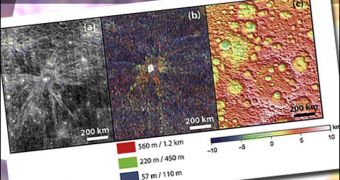A group of researchers at the California Institute of Technology (Caltech), in Pasadena, announce the creation of the first complete set of lunar surface roughness maps. The datasets used to compile the new products were provided by a highly-successful NASA mission.
The Lunar Reconnaissance Orbiter (LRO) used its Lunar Orbiter Laser Altimeter (LOLA) instrument to collect vast amounts of readings of the Moon's surface. The Caltech team contributed their part by putting all the data together.
Some of the most noticeable features on the surface of Earth's natural satellite include heavy impact craters, sprayed ejecta cones, traces of volcanic flows, discolored regions, and other collision marks.
As with the Earth and Mars, the Moon was battered with extreme intensity during a period in the early solar system called the Late Heavy Bombardment. Massive amounts of asteroids and comets made their way into the inner solar system at the time, slamming into the rocky planets.
The satellite protected Earth from some of the heaviest impacts, and this is obvious when looking at the massive amount of damage it suffered. By studying the way the surface is shaped, experts can now draw a wealth of information about the events that caused these scars.
But this is only now becoming possible. The creation of high-resolution surface roughness maps was absolutely essential for this field of research to get off the ground. Creating the maps without the LRO or LOLA would have been impossible.
LOLA is a multi-beam laser altimeter, the first instrument of this kind to fly on an orbiter. A total of five laser beams are shot from the instrument at any given time. Based on the time it takes for them to return, the instrument calculates surface elevations.
“That's very special because it allows us to measure the true gradient of the surface at a particular scale,” explains graduate student Meg Rosenburg, the first author of the paper detailing the maps.
She conducted the research – which is detailed in the latest issue of the esteemed scientific Journal of Geophysical Research – together with advisor Oded Aharonson. Surface roughness is the “culmination of all the processes that have worked to create and modify” the lunar surface, Rosenburg adds.
"The landforms that make up different terrains on a planetary surface are created and modified by landscape processes that act at different scales, sometimes competing with each other,” she says.
“This suite of processes, whatever they are for a particular body, can change over time and as a result the terrain evolves,” the graduate student goes on to say. She explains that now, research teams around the world will be able to study the lunar surface in more detail than ever before.

 14 DAY TRIAL //
14 DAY TRIAL //